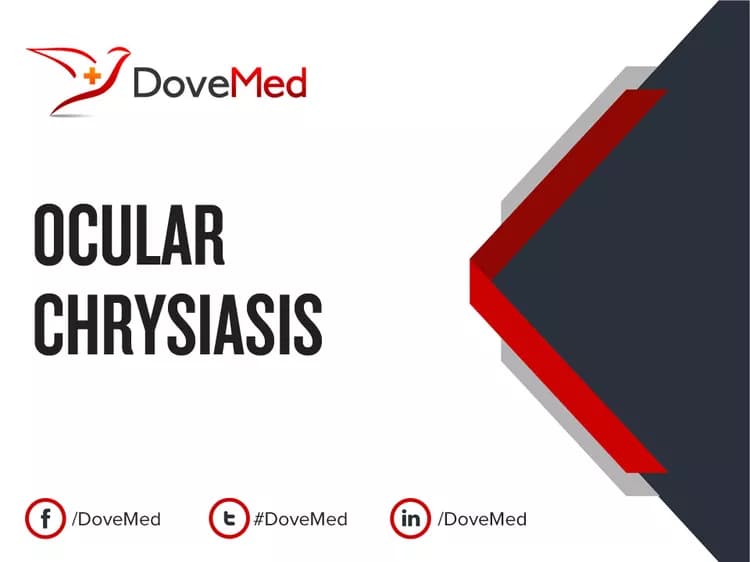What are the other Names for this Condition? (Also known as/Synonyms)
- Gold Deposits in the Eye
- Golden Eye
- Ocular Chrysoderma
What is Ocular Chrysiasis? (Definition/Background Information)
- Ocular Chrysiasis is the yellowish-brown to purple-violet discoloration of the eye, typically caused by gold therapy, which is administered for rheumatoid arthritis (RA)
- This condition is rare and is associated with long-term treatment using gold salts. However, the discoloration is usually permanent, though the color may fade with time
- Ocular Chrysiasis can occur in up to 40% of the individuals taking gold therapy. However, in most of the affected individuals, the vision remains unaffected
- Generally, individuals with Ocular Chrysiasis may have received intramuscular gold-based injections for a long period of time (usually many years). These gold injections not only affect the eye and skin, but other parts of the body too, such as the kidney or liver, due to gold toxicity
- Currently, there is no treatment available for Ocular Chrysiasis. Following onset of Ocular Chrysiasis, the stoppage or discontinuation of gold therapy will not cure or reverse the condition
Who gets Ocular Chrysiasis? (Age and Sex Distribution)
- Ocular Chrysiasis is an infrequent side effect that occurs in individuals who have been treated with gold-based medications for RA and other similar autoimmune conditions
- There is no specific preference for any gender (both males and females are affected)
- All racial and ethnic groups are affected and no predilection is observed
What are the Risk Factors for Ocular Chrysiasis? (Predisposing Factors)
- Individuals with rheumatoid arthritis who receive long-term intramuscular injections containing gold, as part of therapy, are at risk for Ocular Chrysiasis
It is important to note that having a risk factor does not mean that one will get the condition. A risk factor increases ones chances of getting a condition compared to an individual without the risk factors. Some risk factors are more important than others.
Also, not having a risk factor does not mean that an individual will not get the condition. It is always important to discuss the effect of risk factors with your healthcare provider.
What are the Causes of Ocular Chrysiasis? (Etiology)
Ocular Chrysiasis is caused by the administration of gold-based therapy as part of treatment for rheumatoid arthritis, usually for many years.
- Gold is generally administered (in oral tablet form or as injections) to reduce joint inflammation and pain caused by RA
- This condition occurs when the gold particles cause an immune reaction in the eye
When gold is injected to the muscles, it can also travel to different parts of the body causing toxicity, since gold is a foreign body.
What are the Signs and Symptoms of Ocular Chrysiasis?
The signs and symptoms associated with Ocular Chrysiasis include:
- The presence of yellow-brown to purple-violet granules in the sclera or white of the eye
- The lens or cornea of the eye is affected and can show increased pigmentation
- Usually both eyes are affected, but one eye may be affected more than the other
- Some individuals may have photophobia, which is aversion to bright light (in rare cases)
- In many individuals, the vision is not affected. In some, it can diminish vision and color perception
- One may tend to see colored halos around ‘objects’
- The skin may also show blue-grey to purple-grey discoloration on sun-exposed areas; a condition termed as chrysiasis
- Signs and symptoms of underlying rheumatoid arthritis
- There may be underlying gold toxicity signs and symptoms (due to gold therapy), which can include:
- Inflammation of skin, or dermatitis
- Damage to the kidneys, or nephritis
- Damage to the platelet function causing thrombocytopenia purpura
- Inflammation of blood vessels, known as vasculitis
How is Ocular Chrysiasis Diagnosed?
The diagnosis of the Ocular Chrysiasis may involve:
- A complete physical examination and an assessment of the individual’s medical history including history and treatment of rheumatoid arthritis with gold
- Computed tomography (CT) and magnetic resonance imaging (MRI) scan of the head and neck region
- Slit lamp eye examination
Ocular Chrysiasis may be associated with chrysiasis of the skin. In such cases, a tissue biopsy of the affected skin region may be performed.
- Tissue biopsy of the affected skin: A tissue biopsy is performed and sent to a laboratory for a pathological examination. The pathologist examines the biopsy under a microscope. After putting together clinical findings, special studies on tissues (if needed) and with microscope findings, the pathologist arrives at a definitive diagnosis
Note: A tissue biopsy of the affected region of the eye is not needed for diagnosis, and hence, should not be performed.
Many clinical conditions may have similar signs and symptoms. Your healthcare provider may perform additional tests to rule out other clinical conditions to arrive at a definitive diagnosis.
What are the possible Complications of Ocular Chrysiasis?
The complications associated with Ocular Chrysiasis can include:
- Emotional and mental stress due to cosmetic disfigurement
- Ocular Chrysiasis can be associated with underlying severe gold toxicity, resulting in many vital organs being affected
How is Ocular Chrysiasis Treated?
- There is no treatment or cure for Ocular Chrysiasis
- Alternative therapy for rheumatoid arthritis should be considered
How can Ocular Chrysiasis be Prevented?
- Currently, there are no specific methods or guidelines to prevent Ocular Chrysiasis
- The gold-based therapy injections that caused the condition may be discontinued or alternative medications used. However, Ocular Chrysiasis is an irreversible condition
What is the Prognosis of Ocular Chrysiasis? (Outcomes/Resolutions)
- Ocular Chrysiasis is a permanent side effect of gold therapy, which is used for treating rheumatoid arthritis. However, in a majority of the individuals, their sight is not affected
- Discontinuing the therapy responsible for the side effect will generally not reverse the condition and Ocular Chrysiasis can be present for a lifetime
- However, with time, the pigmentation can slowly fade (over many years) after stopping treatment
The prognosis of Ocular Chrysiasis is generally excellent, since it does not affect one’s vision. However, the overall prognosis of the individual is dependent upon the severity of the underlying gold toxicity’ signs and symptoms.
Additional and Relevant Useful Information for Ocular Chrysiasis:
- In 50% of the individuals, the injections (given as part of therapy for various arthritic forms) may not be an effective treatment tool
- Because of the heavy side effects and newer, advanced treatments for arthritis, gold therapy is on the decline; hence, gold toxicity is less frequently seen nowadays
Related Articles
Test Your Knowledge
Asked by users
Related Centers
Related Specialties
Related Physicians
Related Procedures
Related Resources
Join DoveHubs
and connect with fellow professionals


0 Comments
Please log in to post a comment.